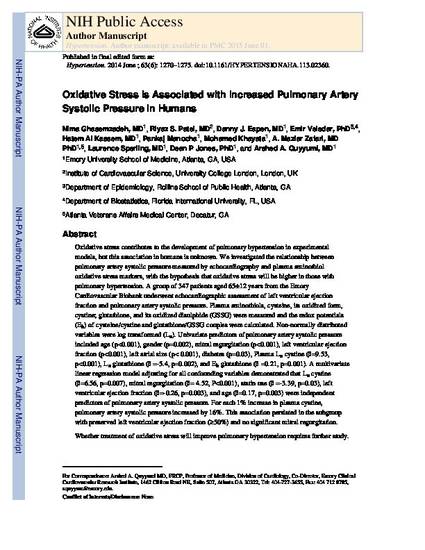
Oxidative stress contributes to the development of pulmonary hypertension in experimental models, but this association in humans is unknown. We investigated the relationship between pulmonary artery systolic pressure measured by echocardiography and plasma aminothiol oxidative stress markers, with the hypothesis that oxidative stress will be higher in those with pulmonary hypertension. A group of 347 patients aged 65±12 years from the Emory Cardiovascular Biobank underwent echocardiographic assessment of left ventricular ejection fraction and pulmonary artery systolic pressure. Plasma aminothiols, cysteine, its oxidized form, cystine; glutathione, and its oxidized disulphide (GSSG) were measured and the redox potentials (Eh) of cysteine/cystine and glutathione/GSSG couples were calculated. Non-normally distributed variables were log transformed (Ln). Univariate predictors of pulmonary artery systolic pressure included age (p<0.001), gender (p=0.002), mitral regurgitation (p<0.001), left ventricular ejection fraction (p<0.001), left atrial size (p< 0.001), diabetes (p=0.03), Plasma Ln cystine (β=9.53, p<0.001), Ln glutathione (β =-5.4, p=0.002), and Eh glutathione (β =0.21, p=0.001). A multivariate linear regression model adjusting for all confounding variables demonstrated that Ln cystine (β=6.56, p=0.007), mitral regurgitation (β= 4.52, P<0.001), statin use (β =-3.39, p=0.03), left ventricular ejection fraction (β=-0.26, p=0.003), and age (β=0.17, p=0.003) were independent predictors of pulmonary artery systolic pressure. For each 1% increase in plasma cystine, pulmonary artery systolic pressure increased by 16%. This association persisted in the subgroup with preserved left ventricular ejection fraction (≥50%) and no significant mitral regurgitation.
Whether treatment of oxidative stress will improve pulmonary hypertension requires further study.
Available at: http://works.bepress.com/emir-veledar/9/

Post Print Version.
The final version of this article was published in Hypertension.